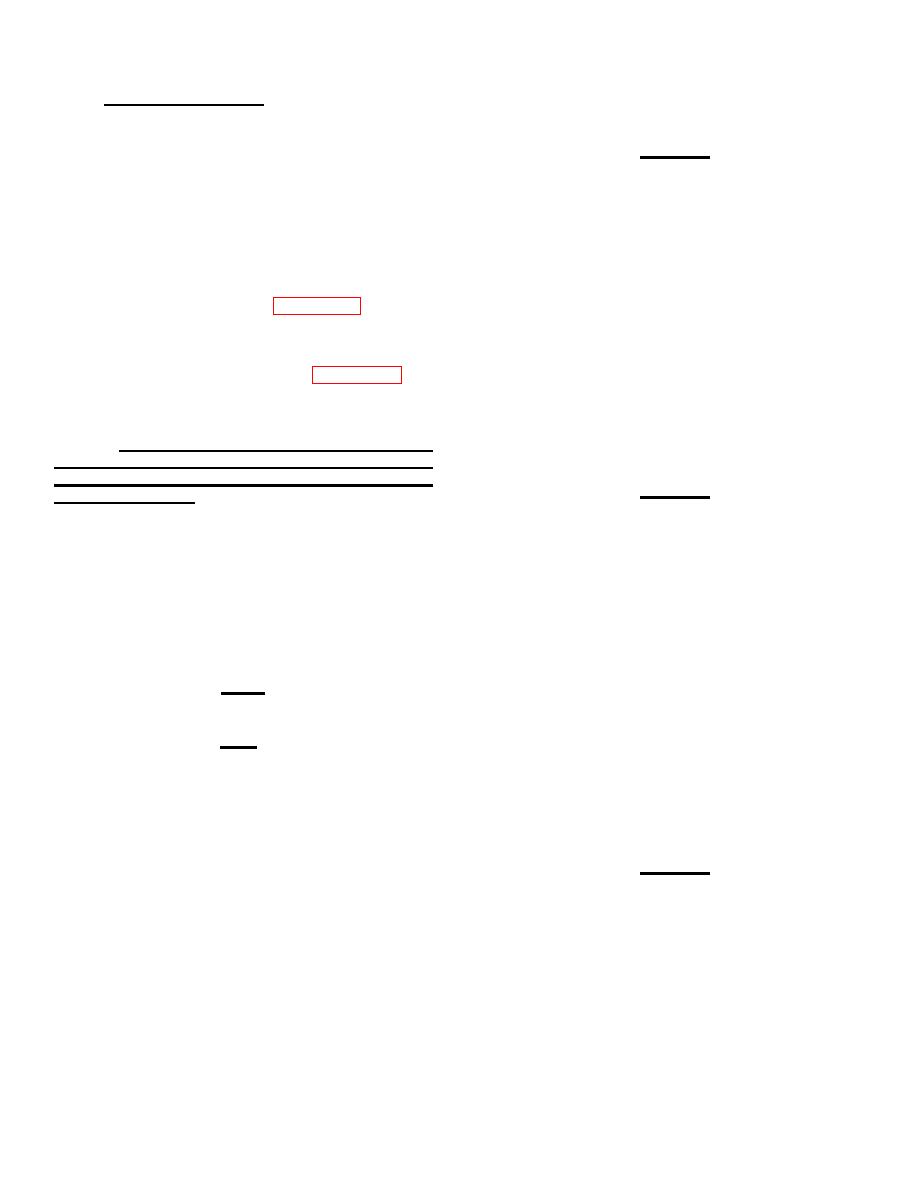
TM 11-5840-360-14-1-1
2.11.5 Cable Connections (V4)
The center probe is designed to fit snugly over
Access to the terminal boards in the S-band
the center conductor; a pressure sealing adhesive (such
antenna pedestal is provided via the hinged access
as LOCTITE ) should be used to secure the probe,
cover on the front of the pedestal assembly. The cover
CAUTION
is secured by six captive fasteners. Terminal board TB1
THE DISTANCE THAT THE PROBE
is on the left inside the hatch, TB2 and TB3 on the right.
EXTENDS INTO THE WAVEGUIDE-
Two cables provide the electrical interconnec-
TO-CABLE
TRANSITION
IS
tions for the S-band antenna pedestal. One cable
CRITICAL: THE PROBE MUST BE
carries control signals to and from the pedestal; the
TAPPED
ONTO
THE
CENTER
other, an armored cable (FSGA-9), carries power for the
CONDUCTOR UNTIL THE DISTANCE
antenna drive motor. The cables enter through the
FROM THE PROBE TIP TO THE END
bottom of the pedestals via stuffing tubes which are
OF THE TEFLON BUSHING AROUND
supplied in the installation kits; Figure 2-16 shows the
THE CENTER CONDUCTOR IS 1.332
locations at which the stuffing tubes are to be installed.
0.005 INCHES AS MEASURED WITH
The stuffing tube bodies thread directly into the base of
A
CALIPER
(FOR
EARLIER
the pedestals. Cable connections to the terminal boards
MODELS). LATER MODELS HAVE A
inside the pedestals are illustrated in Figure 2-16. For
LONGER PROBE WHICH MAY BE
S-band radars, a four-conductor cable (FSGA-9 or
PUSHED IN ALL THE WAY TO
equivalent) must always be used to carry the antenna
ACHIEVE THE SAME DIMENSIONS.
drive motor power from the receiver transmitter to the
Installation of the waveguide-to-coaxial cable
pedestal, even when a single-phase drive motor is used
transition at the antenna pedestal must be accomplished
(one conductor is required for connection of starting
using the following procedure.
capacitor C2 in the receiver transmitter when a single-
CAUTION
phase motor is used).
IMPROPER INSTALLATION OF THE
The RF interface between the S-band antenna
WAVEGUIDE-TO-COAXIAL
CABLE
pedestal and the S-band receiver transmitter can be
TRANSITION CAN CAUSE DAMAGE
provided via coaxial cable or waveguide. For runs of 65
TO THE ROTARY JOINT; FOLLOW
feet or less, 7/8-inch EIA foam dielectric coaxial cable is
THE PROCEDURE CAREFULLY.
recommended; Raytheon part numbers for ordering the
cable and accessories are:
1. Locate two mounting holes in tabs extending
Cable: 168856-1 or -2
from pedestal housing which are in-line with rotary joint
Connectors (two required): 168857-1 or -2
waveguide section; insert cap screw (167976-1,
Elbow, 90 Coaxial (optional): 168857-3
,
contained in pedestal installation kit) in each mounting
Hardware kit: (Part No. to be supplied)
hole and start two 1/4-20 nuts (20-1167P1, in pedestal
installation kit) on each screw (do not tighten).
NOTE
The dash numbers for the cable and
2. Position waveguide-to-coaxial cable transition
connectors (-1 or -2) must agree, e.i.
(167175-1) in-line with rotary joint waveguide section
-1 connectors must be used on -1
and insert cap screws through mounting holes on
transition. Start one 1/4-20 nut on bottom of each cap
cable.
screw.
For runs exceeding 100 feet, S-band waveguide
is recommended.
3. Adjust two lower nuts on each screw to coarsely
In installations using RF coaxial cable
align flange on transition with that on rotary joint
transmission line, two waveguide-to-cable transitions
waveguide section; leave loose enough to allow
(Raytheon part number 167175-1) are required to
insertion of gasket and alignment of flanges.
interface the cable with waveguide fittings at both the
CAUTION
antenna pedestal and receiver transmitter. Also, a
WHEN SECURING TRANSITION, DO
center probe (part number 166313-1) must be installed
NOT APPLY FORCE TO ROTARY
on both ends of the RF cable center conductor after the
JOINT OR ALLOW WEIGHT OF
conductors are assembled. Cable preparation and
TRANSITION TO STRESS ROTARY
connector assembly instructions are provided in the
JOINT.
installation kit.
2-60


 Previous Page
Previous Page
